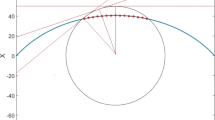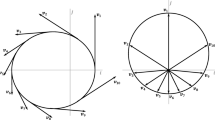Abstract
A simplex method of orbit determination (SMOD) is presented to solve the problem of orbit determination for maneuvering satellites subject to small and continuous thrust. The objective function is established as the sum of the nth powers of the observation errors based on global positioning satellite (GPS) data. The convergence behavior of the proposed method is analyzed using a range of initial orbital parameter errors and n values to ensure the rapid and accurate convergence of the SMOD. For an uncontrolled satellite, the orbit obtained by the SMOD provides a position error compared with GPS data that is commensurate with that obtained by the least squares technique. For low Earth orbit satellite control, the precision of the acceleration produced by a small pulse thrust is less than 0.1% compared with the calibrated value. The orbit obtained by the SMOD is also compared with weak GPS data for a geostationary Earth orbit satellite over several days. The results show that the position accuracy is within 12.0 m. The working efficiency of the electric propulsion is about 67% compared with the designed value. The analyses provide the guidance for subsequent satellite control. The method is suitable for orbit determination of maneuvering satellites subject to small and continuous thrust.
Similar content being viewed by others
References
Y. Zhang, J. Rocket Propul. 31, 27 (2005).
K. N. Kozubskii, V. M. Murashko, Y. P. Rylov, Y. V. Trifonov, V. P. Khodnenko, V. Kim, G. A. Popov, and V. A. Obukhov, Plasm. Phys. Rep. 29, 251 (2003).
L. B. King, A. D. Gallimore, and C. M. Marrese, J. Propul. Power 14, 327 (1998).
C. E. Garner, M. D. Rayman, and J. R. Brophy, In-flight operation of the Dawn ion propulsion system through start of the Vesta cruise phase, AIAA Paper No. 2009-5091, 2009.
T. P. Zhang, and X. E. Zhang, Vacuum Cryogen. 19, 187 (2013).
G. Beutler, M. R. Drinkwater, R. Rummel, and R. Von Steiger, Earth Gravity Field from Space-from Sensors to Earth Sciences (Springer, Netherlands, 2003), p. 419.
G. Beutler, E. Brockmann, W. Gurtner, U. Hugentobler, L. Mervart, and M. Rothacher, Manuscr. Geod. 19, 367 (1994).
T. H. Xu, N. Jiang, and Z. Z. Sun, Sci. China-Phys. Mech. Astron. 55, 892 (2012).
F. Cao, X. H. Yang, Z. G. Li, B. Q. Sun, Y. Kong, L. Chen, and C. Feng, Adv. Space Res. 54, 1828 (2014).
H. S. Lin, H. Huang, G. Liu, and H. E. Bing, Electron. Opt. & Control 22, 64 (2015).
R. Guo, X. J. Li, J. H. Zhou, L. Liu, and Y. Huang, J. Geomat. Sci. Technol. 30, 465 (2013).
Z. K. Zhang, S. J. Chen, L. Du, Q. Y. Danzeng, H. Wang, and Q. F. Zhang, J. Astronaut. 35, 506 (2014).
H. N. Li, J. S. Li, and Y. X. Huang, Sys. Eng. Electron. 32, 1957 (2010).
X. Y. Song, X. L. Jia, W. H. Jiao, and Y. Mao, Geomat. Inf. Sci. Wuhan Univ. 34, 573 (2009).
Y. Zhang, M. Chen, J. F. Duan, and J. F. Xie, Mann. Spacefl. 19, 45 (2013).
W. Spendley, G. R. Hext, and F. R. Himsworth, Technometrics 4, 441 (1962).
J. A. Nelder, and R. Mead, Comp. J. 7, 308 (1965).
Z. Wu, and L. F. Gou, Comp. Simul. 31, 64 (2014).
J. F. Chen, Z. W. Ren, and X. N. Fan, in Proceedings of the 25th Chinese Control Conference, 7-11 August, 2006, Harbin, China, edited by G. Z. Cheng and G. R. Duan (Beihang University Press, Beijing China, 2006), pp. 1448–1453.
F. G. Yuan, X. H. Zhang, and J. W. Yang, J. Suzhou U. Sci. Technol. (Nat. Sci.) 28, 33 (2011).
L. W. Liao, Y. D. Cui, T. Chen, and C. Qiu, Metall. Anal. 25, 7 (2005).
C. F. Juang, I. F. Chung, and C. H. Hsu, Fuzzy Sets Syst. 158, 1979 (2007).
H. Xiao, Y. Shao, X. Zhou, and S. J. Wilcox, Measurement 55, 25 (2014).
B. Ye, H. B. Zhang, and J. Wu, J. Astronaut. 30, 1371 (2009).
C. Clemen, Acta Astronaut. 51, 457 (2002).
Q. L. Kong, J. Y. Guo, and C. M. Zhao, Sci. Surv. Map. 41, 165 (2016).
B. D. Tapley, E. S. Bob, and H. B. George, Statistical Orbit Determination (Elsevier Academic Press, USA, 2004), p. 50.
G. C. Xu, and J. Xu, Orbits-2nd Order Singularity-free Solutions (2nd Edition, Springer Heidelberg, 2013), p.39.
Y. Huang, X. G. Hu, X. Z. Zhang, D. R. Jiang, R. Guo, H. Wang, and S. B. Shi, Chin. Sci. Bull. 56, 2765 (2011).
J. S. Li, Satellite Precision Orbit Determination (PLA Publishing Press, Beijing, 1995), p. 217.
J. Zhu, J. S. Wang, J. R. Chen, and Y. F. He, J. Astronaut. 34, 163 (2013).
J. Zhu, J. R. Chen, G. Zeng, J. Li, and J. S. Wang, in Proceedings of China Satellite Navigation Conference (CSNC) 2014 Proceedings: Volume III, Nanjing, China, 21-23 May, 2014, edited by J. D. Sun, H. T. Wu, W. H. Jiao and M. Q. Lu (Springer Berlin Heidelberg, Berlin Germany, 2014), pp. 3–14.
M. L. Psiaki, in Proceedings of the 14th International Technical Meeting of the Satellite Division of the Institute of Navigation (ION GPS 2001), Salt Lake City, 11-14 September, 2001, pp. 2838–2850.
W. L. Mao, and A. B. Chen, AEU -Int. J. Electron. Commun. 63, 665 (2009).
Y. J. Xie, Weak GPS Signal Processing and Autonomous Navigation of High Earth Orbits Spacecraft, Dissertation for the Doctoral Degree, (Harbin Engineering University, Harbin, 2011), pp. 44–70.
M. Sahmoudi, M. G. Amin, and R. Jr Landry, in Proceedings of IEEE/ION Position, Location and Navigation Symposium 2008, Monterey, America, 6-8 May, 2008, pp. 1362–1372.
S. Lemmens, and H. Krag, J. Guidance Control Dyn. 37, 860 (2014).
Author information
Authors and Affiliations
Corresponding author
Rights and permissions
About this article
Cite this article
Chen, J., Li, J., Wang, X. et al. A simplex method for the orbit determination of maneuvering satellites. Sci. China Phys. Mech. Astron. 61, 024511 (2018). https://doi.org/10.1007/s11433-017-9102-1
Received:
Accepted:
Published:
DOI: https://doi.org/10.1007/s11433-017-9102-1




